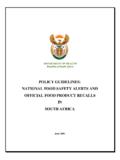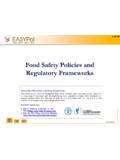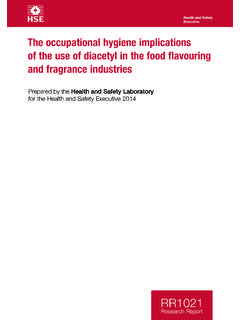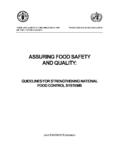Transcription of Food hygiene - Food and Agriculture Organization
1 food hygieneBasic textsFourth edition ISSN 0259-2916 food hygiene Basic textsFourth edition WORLD HEALTH ORGANIZATIONFOOD AND Agriculture Organization OF THE UNITED NATIONSRome, 2009 The designations employed and the presentation of material in this information product do not imply the expression of any opinion whatsoever on the part of the food and Agriculture Organization of the United Nations (FAO) or of the World Health Organization (WHO) concerning the legal or development status of any country, territory, city or area or of its authorities, or concerning the delimitation of its frontiers or boundaries.
2 The mention of specific companies or products of manufacturers, whether or not these have been patented, does not imply that these have been endorsed or recommended by FAO or WHO in preference to others of a similar nature that are not mentioned. ISBN 978-92-5-105913-5 All rights reserved. Reproduction and dissemination of material in this information product for educational or other non-commercial purposes are authorized without any prior written permission from the copyright holders provided the source is fully acknowledged. Reproduction of material in this information product for resale or other commercial purposes is prohibited without written permission of the copyright holders.
3 Applications for such permission should be addressed to: Chief Electronic Publishing Policy and Support BranchCommunication Division FAO Viale delle Terme di Caracalla, 00153 Rome, Italy or by e-mail to: FAO and WHO 2009P R E F A C ETHE CODEX ALIMENTARIUS COMMISSIONThe Codex Alimentarius Commission is an intergovernmental body with more than 180 members, within the framework of the Joint food Standards Programme established by the food and Agriculture Organization of the United Nations (FAO) and the World Health Organization (WHO), with the purpose of protecting the health of consumers and ensuring fair practices in the food trade.
4 The Commission also promotes coordination of all food standards work undertaken by international governmental and non-governmental organizations. The Codex Alimentarius (Latin, meaning food Law or Code) is the result of the Commission s work: a collection of internationally adopted food standards, guidelines, codes of practice and other recommendations. The texts in this publication are part of the Codex hygiene (BASIC TEXTS)Fourth editionThe Codex basic texts on food hygiene promote understanding of how rules and regulations on food hygiene are developed and applied.
5 The General Principles of food hygiene cover hygiene practices from primary production through to final consumption, highlighting the key hygiene controls at each stage. This publication also contains the most internationally used description of the Hazard Analysis and Critical Control Point (HACCP) system and guidelines for its application. This fourth edition includes texts adopted by the Codex Alimentarius Commission up to 2009. The texts will be of use to government authorities, food industries, food handlers and consumers, as well as teachers and students of food information on these texts, or any other aspect of the Codex Alimentarius Commission, may be obtained from: The Secretary Codex Alimentarius Commission Joint FAO/WHO food Standards Programme Viale delle Terme di Caracalla 00153 Rome, Italy Fax: +39 06 57054593 E-mail: http.
6 // C O N T E N T SFOOD hygiene (BASIC TEXTS)Fourth editionPREFACE iiiRECOMMENDED INTERNATIONAL CODE OF PRACTICE GENERAL PRINCIPLES OF food hygiene 1 CAC/RCP 1-1969 PRINCIPLES FOR THE ESTABLISHMENT AND APPLICATION OF MICROBIOLOGICAL CRITERIA FOR FOODS 35 CAC/GL 21-1997 PRINCIPLES AND GUIDELINES FOR THE CONDUCT OF MICROBIOLOGICAL RISK ASSESSMENT 43 CAC/GL 30-1999 PRINCIPLES AND GUIDELINES FOR THE CONDUCT OF MICROBIOLOGICAL RISK MANAGEMENT (MRM) 51 CAC/GL 63-2007 GENERAL STANDARD FOR IRRADIATED FOODS 77 CODEX STAN 106-1983 RECOMMENDED INTERNATIONAL CODE OF PRACTICE FOR RADIATION PROCESSING OF food 81 CAC/RCP 19-1979 GUIDELINES ON THE APPLICATION OF GENERAL PRINCIPLES OF food hygiene TO THE CONTROL OF LISTERIA MONOCYTOGENES IN FOODS 89 CAC/GL 61-20071 RECOMMENDED INTERNATIONAL CODE OF PRACTICE GENERAL PRINCIPLES OF food HYGIENECAC/RCP 1-1969 INTRODUCTION 3 SECTION 1 OBJECTIVES The Codex General Principles of food hygiene 4 SECTION 2 SCOPE.
7 USE AND DEFINITION Scope Use Definitions 5 SECTION 3 PRIMARY PRODUCTION Environmental hygiene Hygienic production of food sources Handling, storage and transport Cleaning, maintenance and personnel hygiene at primary production 7 SECTION 4 ESTABLISHMENT: DESIGN AND FACILITIES Location Premises and rooms Equipment Facilities 10 SECTION 5 CONTROL OF OPERATION Control of food hazards Key aspects of hygiene control systems Incoming material requirements Packaging Water Management and supervision Documentation and records Recall procedures 15 SECTION 6 ESTABLISHMENT.
8 MAINTENANCE AND SANITATION Maintenance and cleaning Cleaning programmes Pest control systems Waste management Monitoring effectiveness 18 Adopted in 1997. Amended 1999. Revision 7 ESTABLISHMENT: PERSONAL hygiene Health status Illness and injuries Personal cleanliness Personal behaviour Visitors 19 SECTION 8 TRANSPORTATION General Requirements Use and maintenance 20 SECTION 9 PRODUCT INFORMATION AND CONSUMER AWARENESS Lot identification Product information Labelling Consumer education 21 SECTION 10 TRAINING Awareness and responsibilities Training programmes Instruction and supervision Refresher training 22 ANNEX
9 HAZARD ANALYSIS AND CRITICAL CONTROL POINT (HACCP) SYSTEM AND GUIDELINES FOR ITS APPLICATION 23 Preamble 23 Definitions 24 Principles of the HACCP system 24 Guidelines for the application of the HACCP system 253 RECOMMENDED INTERNATIONAL CODE OF PRACTICE GENERAL PRINCIPLES OF food HYGIENECAC/RCP 1-1969 INTRODUCTIONP eople have the right to expect the food they eat to be safe and suitable for consumption.
10 Foodborne illness and foodborne injury are at best unpleasant; at worst, they can be fatal. But there are also other consequences. Outbreaks of foodborne illness can damage trade and tourism, and lead to loss of earnings, unemployment and litigation. food spoilage is wasteful, costly and can adversely affect trade and consumer food trade and foreign travel are increasing, bringing important social and economic benefits. But this also makes the spread of illness around the world easier. Eating habits too have undergone major change in many countries over the last two decades and new food production, preparation and distribution techniques have developed to reflect this.













